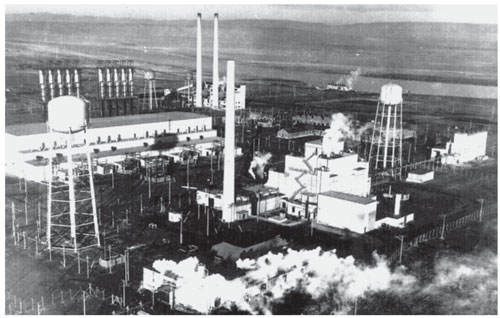
This Article From Issue
May-June 2007
Volume 95, Number 3
Page 266
DOI: 10.1511/2007.65.266
Plutonium: A History of the World's Most Dangerous Element. Jeremy Bernstein. xii + 216 pp. Joseph Henry Press, 2007. $27.95.
Our solar system was originally endowed with plutonium as well as uranium, but that plutonium is long gone. The half-life of the element's most important isotope, plutonium239, is just 24,000 years—a very long time by any human measure, but short compared with the age of the solar system. So almost all of the 2,000 metric tons or so of plutonium that exists on Earth today was made in nuclear reactors; about 250 tons of it was created for use in weapons, and the rest came into being as a by-product of the operation of civilian nuclear-power reactors.

From Plutonium.
After an atom of uranium-238 absorbs a neutron, it decays within a few days into plutonium-239. The plutonium can then be separated chemically from the uranium to make bombs. The bomb dropped at Nagasaki contained 6 kilograms of plutonium, of which 1 kilogram fissioned. The International Atomic Energy Agency assumes that, including the amount that would be lost during production, about 8 kilograms would be required to make a bomb. At that rate, 2,000 tons of plutonium would be sufficient to make a quarter of a million Nagasaki bombs!
Preventing additional states or terrorist groups from gaining the ability to use plutonium in this way is the central challenge of nuclear nonproliferation. Disposing of plutonium is very important in this regard; it also helps to make arms reductions on the part of existing nuclear powers largely irreversible.
In his short new book Plutonium, Jeremy Bernstein, a physicist and veteran science journalist, tells the story of the discovery of the element and its properties. He also sketches in the larger background of the development of atomic and nuclear physics during the first half of the 20th century and includes capsule biographies of the atomic and nuclear physicists who made the big discoveries—Henri Becquerel, Ernest Rutherford, Niels Bohr, Enrico Fermi, Lise Meitner, Leo Szilard, Glenn Seaborg and others. Their names are already familiar to physicists interested in nuclear matters, but Bernstein's anecdotes reveal their human sides. He also brings to life such lesser-known figures as William Zachariasen, who determined the crystal phases of plutonium and its various compounds.
Plutonium was first made for nuclear bombs during the Manhattan Project. Until late in the weapons program, the Los Alamos scientists were convinced that they were in a nuclear-arms race with their counterparts in Nazi Germany. It turned out, however, that although the Germans understood the physics, they never got very far either in making plutonium or in enriching uranium in the chain-reacting isotope U-235, which is present in natural uranium at a concentration of only 0.7 percent.
Bernstein raises—not for the first time—some interesting questions about this one-sided nuclear arms race: What if Fermi had realized that he was causing uranium fission in his neutron experiments in 1934, four years before Lise Meitner and her nephew Otto Frisch used fission to explain the puzzling chemical properties of the products of German experiments with neutron irradiation of uranium? Might World War II have been nuclear from the beginning?
Or what if the Nazis had penetrated the Manhattan Project (as the Soviets did) and learned that it had been a mistake to reject the use of graphite to slow fission neutrons? Then might Germany too have built graphite-"moderated" plutonium-production reactors instead of failing in its effort to acquire enough heavy water from Norway to make possible a chain reaction in natural uranium?
If the Germans had succeeded in making plutonium, they would still have had a large obstacle to overcome, however, in the actual design of a nuclear weapon. Spontaneous fission of the small amount of plutonium-240 contained in 6 kilograms of weapons-grade plutonium emits a stream of neutrons at an average rate of one per 10 microseconds. As Bernstein points out, these neutrons make it infeasible to adapt for plutonium the simple gun-type design that brought together a supercritical mass of highly enriched uranium in the Hiroshima bomb. During the hundreds of microseconds that this assembly would be ramping up to full super-criticality, the neutrons would start the plutonium chain reaction prematurely and the device would blow itself apart with a very low explosive yield.
Designing a faster method of assembly for a plutonium explosive became the central challenge for the weapons designers at Los Alamos. Ultimately they had to turn to the implausible idea of imploding an initially subcritical mass of plutonium to a supercritical density. This was facilitated by the fact that weapons plutonium is stabilized in the delta phase with a density of about 16 grams per cubic centimeter but is converted under pressure into alpha phase, which has a density of about 20 grams per cubic centimeter.
Bernstein summarizes what happened after Nagasaki only briefly in a final chapter, titled "Now What?" This is disappointing, because "Now what?" is, of course, the question of primary concern to those who worry about how to deal with all of the plutonium that has been created.
In the year 2000, after several years of negotiations, Russia and the United States sought to make their nuclear reductions more assuredly permanent by agreeing that each would make at least 34 tons of their excess weapons plutonium largely inaccessible—primarily by making it into fuel for power reactors. Only a fraction of the plutonium would be fissioned; but inside spent fuel, plutonium is protected from easy recovery by the presence of fission products that release lethal gamma radiation. (Plutonium itself only gives off alpha particles, which are not energetic enough even to penetrate skin; hence, pure plutonium is easy to transport and manipulate inside a glove box, which provides protection against inhalation or ingestion of plutonium particles.)
The costs of the U.S. plutonium-disposition program have been escalating rapidly, and Russia has made it clear that its own program will go forward only if fully financed by the United States and other interested countries. The future of both efforts is currently in question. An alternative and potentially less costly approach that has been considered from time to time in the United States would be to mix the plutonium back into the fission-product waste from which it had earlier been separated, and then encapsulate the waste in glass for disposal.
In addition to the 250 tons of weapons plutonium that exists, another 250 tons of plutonium has been separated from irradiated civilian reactor fuel. Civilian plutonium separation began in the 1960s and 1970s in support of the huge but failed effort by the industrialized world to commercialize plutonium "breeder" reactors, so named because they make more fuel than they consume. The separated civilian plutonium was to provide start-up fuel for these reactors, which transform the abundant non-chain-reacting isotope of uranium (uranium-238) into more plutonium reactor fuel.
Civilian spent-fuel reprocessing was abandoned in the United States, however, after India conducted a "peaceful" nuclear explosion in 1974 using the first plutonium it had separated in a U.S.-supported reprocessing program. Attempts to commercialize breeder reactors have failed in Europe and Japan, but the French and Japanese nuclear establishments continue to reprocess and to talk of a second effort to build breeders some decades hence.
Reprocessing is being abandoned in some countries more slowly than are breeder reactors, in large part because nuclear utilities are being pressed to show that they know what to do with their spent fuel while not-in-my-backyard forces are blocking the establishment of centralized storage sites. Reprocessing spent fuel is much more costly than storing it but looks better than letting it accumulate indefinitely at the nuclear-power plants.
A similar impasse over the licensing of a geological repository for U.S. spent fuel under Yucca Mountain in Nevada has inspired the Bush administration's Department of Energy to propose building a huge, federally funded reprocessing plant to which U.S. utilities could ship their spent fuel. After separation, however, most of the plutonium would simply be stored until the uncertain day when reactors are commercialized that can dispose of it more efficiently than can current-generation reactors.
But it is absurd that one group in the Department of Energy is proposing to spend tens of billions of dollars to separate plutonium from spent civilian reactor fuel while another group in the same agency is proposing to spend many billions to do the opposite: dispose of excess separated plutonium in spent civilian reactor fuel!
Bernstein's book should play a useful role by helping to demystify plutonium and by encouraging interested members of the public and Congress to start constructing a more rational policy to deal with the dangers posed by this man-made element.

American Scientist Comments and Discussion
To discuss our articles or comment on them, please share them and tag American Scientist on social media platforms. Here are links to our profiles on Twitter, Facebook, and LinkedIn.
If we re-share your post, we will moderate comments/discussion following our comments policy.